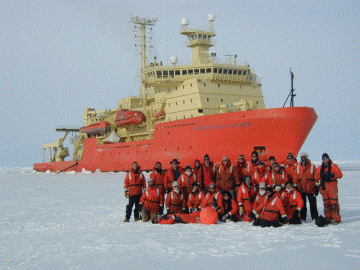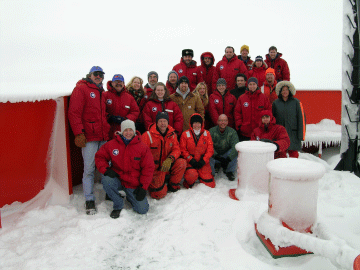AnSlope was an oceanographic experiment carried out during 2003-2005 in the Ross Sea,
Antarctica, in collaboration with Arnold L. Gordon, Stan Jacobs, Martin Visbeck, William Smethie
and Peter Schlosser of the Lamont-Doherty Earth Observatory (LDEO); Laurence Padman and Robin
Muench of the Earth and Space Research (ESR); and Dale Pillsbury of Oregon State University (OSU).
Further information about this program can be found in the related AnSlope sites at
LDEO,
ESR, and
OSU.
The influence of cold Antarctic waters originating in to the global ocean
circulation and climate is now well understood, but the processes by which these water masses enter
the deep ocean circulation are not. AnSlope addresses this problem. We identify the upper
continental slope as the critical gateway for the exchange of shelf and deep ocean waters. Here
the topography, velocity and density fields associated with the nearly ubiquitous Antarctic Slope
Front (ASF) must strongly influence the advective and turbulent transfer of water properties
between the shelf and oceanic regimes.
Goal
To identify and characterize the principal physical processes that govern
the transfer of shelf-modified dense water into intermediate and deep layers of the adjacent deep
ocean, and the compensatory poleward flow of waters from the oceanic regime.
Objectives
- Determine the ASF mean structure and the principal scales of variability
(spatial from ~1 km to ~100 km, and temporal from tidal to seasonal), and
estimate the role of the Front on cross-slope exchanges and mixing of
adjacent water masses;
- Determine the influence of slope topography (canyons, proximity to a
continental boundary, isobath divergence/convergence) on frontal location
and outflow of dense Shelf Water;
- Establish the role of frontal instabilities, benthic boundary layer
transports, tides and other oscillatory processes on cross-slope advection
and fluxes; and
- Assess the effect of diapycnal mixing (shear-driven and double-diffusive),
lateral mixing identified through intrusions, and nonlinearities in the
equation of state (thermobaricity and cabbeling) on the rate of descent
and fate of outflowing, near-freezing Shelf Water.
Field Program
Acquisition of measurements is focused over the outer continental shelf and the
upper slope of the northwestern Ross Sea. Field work includes three oceanographic cruises on
the N.B. Palmer icebreaker. During the first two cruises we deployed and recovered instruments
that measured time series of currents and T-S-P series for a year. A third AnSlope cruise will
take place in October-November of 2004. A second year of records will be recovered on the Palmer
in January-February 2005. An integrated basic modeling program will also be undertaken to study
tides, plume dynamics, and frontal dynamics.
Broad summary of the various AnSlope components and principal investigators:
- Moored current meters: A. Orsi, T. Whitworth (TAMU), D. Pillsbury (OSU):
One year of direct current and temperature measurements will characterize the
horizontal and vertical flow structure of the Antarctic Slope Current, its
most important time-varying components from tidal to seasonal scales, and
allow an assessment of the eddy components of cross-slope fluxes of heat,
freshwater and momentum. The current meter array is designed to track the
front's location over time. To maximize chances of achieving complete,
contemporaneous coverage during the most critical period of intensive
measurements (CTD, ADCP, tracers), the array was deployed prior to the
CTD/tracer surveys.
- CTD/ADCP; A. Gordon, S. Jacobs, M. Visbeck (LDEO):
This
component, providing high resolution measurements of the stratification and
velocity shear fields of the outer shelf, slope and intervening fronts,
enables study of vertical coherence of these fields under varied bathymetric
conditions; detects exchanges of water masses between the shelf and slope
regimes, including plumes; and investigates the role of cabbeling and
thermobaric effects. Special attention will be paid to the benthic
spatial scales, particularly within the confines of submarine canyons.
The combined use of hull-mounted and lowered ADCP allows accurate estimates
of the width of frontal jets; provides first order estimates of tidal
velocities; obtains full ocean depth velocity profiles and accurate
estimates of near-bottom flow.
- Microstructure on CTD; L. Padman, R. Muench (ESR): A microstructure
package is mounted on the CTD rosette to obtain direct estimates of the
diapycnal diffusivity, Kv, and to identify the primary
instability processes driving vertical turbulent fluxes. This instrument has
a depth range of ~2000 m and so can sample into the benthic dense plume
out to the central slope.
- CFC and stable isotope tracers; W. Smethie, P. Schlosser (LDEO):
CFCs, isotopes of oxygen and helium, and tritium will be measured on the
Coarse and Fine Scale Resolution surveys. Shelf Water is well ventilated
and contains high CFC concentrations and low He-3 concentrations. Opposite
characteristics are found in the CDW upwelling across the slope. Sharp
contrasts in tracer concentrations and ratios (CFC-113:CFC-11, CFC:tritium)
are observed between Shelf Water types that form underneath the Ice Shelf
or over the continental shelf. CFC, He-3 and hydrographic data are used to
map spreading pathways and to determine exchange and mixing history across
the ASF; dO-18 and total helium data will determine the location of the
sources of outflowing Shelf Water types; ratios will determine residence times.
AnSlope CFC measurements will provide critical information on the
controlling processes for surface and Shelf Water chemistry, such as the
extent to which they are in equilibrium with the atmosphere.
- Tide modeling; L. Padman (ESR): Tides are expected to be the
primary contributor to ocean currents in the study region. The cross-slope
advection due to these periodic currents must be taken into account when assessing
data from the CTD/ADCP/LADCP survey. ESR, in collaboration with OSU, has
created a ~10 km tides model which does quite a good job of estimating current strengths,
but presently does poorly in estimating the tidal current phase along the Ross Sea
continental shelf. ESR and OSU have now created a higher-resolution tidal model
for the Ross Sea, and have improved the model quality for the AnSlope region
by assimilating the vessel-mounted ADCP (VM-ADCP) data collected during
AnSlope Cruise 1 and 2 earlier Ross Sea cruises. We will continue to improve
this model by assimilating more VM-ADCP data from AnSlope cruises 2 and 3, as
well as from the TAMU/OSU moorings when they are recovered.
Acknowledgements
AnSlope is funded by the National Science Foundation, Office of Polar
Programs. It is the 4th in a series of projects under the SCOR-affiliated
International Antarctic Zone (iAnZone) program.



